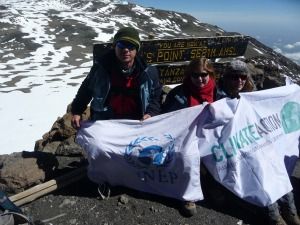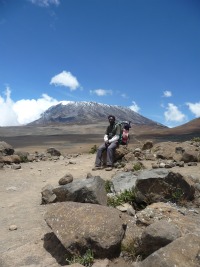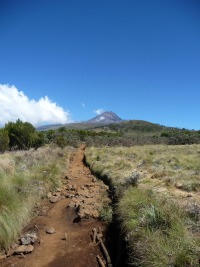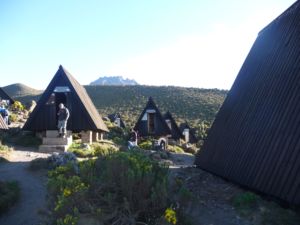Climate Action climbs Kilimanjaro
This years Kilimanjaro Initiative’s (KI) annual climb of Mount Kilimanjaro (28 February – 4 March), was themed environmental and social sustainability. 33 people took part in the climb, including cyclists from Global Bike, youth in Kenya and Tanzania and Climate Action’s Lisa Yazdabadi, who describes her experience.

 Climate Action took part in the Kilimanjaro Initiative’s (KI) annual climb of Mount Kilimanjaro in Tanzania, for the first time last week (28 February - 4 March).
Climate Action took part in the Kilimanjaro Initiative’s (KI) annual climb of Mount Kilimanjaro in Tanzania, for the first time last week (28 February - 4 March).
The initiative aims to raise awareness of and help address the problems facing youth in the urban areas of East Africa, highlighting their role in sustainable development. KI encourage young people to have self-belief and to assist in providing opportunities that will enable them to take on a constructive role in their communities.
Climate Action’s Lisa Yazdabadi takes us through her experience of the climb:
A group of 33, including our two colleagues from UNEP, 10 youth from Kenya and Tanzania, and 11 cyclists from Global Bike, who had earlier cycled from the UN compound in Nairobi to the gates of Kilimanjaro National Park, took part in the climb.
 The theme for this year’s climb was the environmental and social sustainability, as showcased by the ‘Green Economy’ concept to enhance wellbeing, reduce inequities and rebuild economies on a sustainable basis.
The theme for this year’s climb was the environmental and social sustainability, as showcased by the ‘Green Economy’ concept to enhance wellbeing, reduce inequities and rebuild economies on a sustainable basis.
The climb commenced on the Monday (28 February) taking the Marangu route we walked the four hour hike through the jungle to the Mandara Huts where we were welcomed with hot chai and popcorn followed by a delicious dinner.
The following two days took us to Horombo Hut, walking through the beautiful tundra and then onto Kibo Hut, surrounded by ‘Mars like’ scenery of desert, rocks and sparse land. Kibo Hut sits 4200 metres above sea level at the base of Mount Kilimanjaro and was our final stop before we descended on the very long, very cold night of walking (or should I say shuffling up the mountain). After arriving there at 3pm we had just enough time to pack our bag and arrange our five layers of clothing that we would be wearing that evening and most importantly pack our chocolate to fuel us up the scree laden path.
After a light dinner and two hours of attempted sleep (the high altitude makes it very difficult to sleep and causes your heart to feel like you’ve just run a marathon when you are merely lying dormant) we lined up outside Kibo Hut in the bitter cold and darkness to begin the final ascent. All climbers at this stage were feeling the effects of high altitude; breathing was becoming difficult, the cold cut through thermal layers, and many climbers struggled with the effects of nausea and dehydration.
 The youth, young and fit, surged ahead, along with the cyclists, while others took a measured pace, conscious of the long and exhausting night ahead. Our group made up of Stuart Roberts and Joanna Benn from UNEP, Hiser, a freelance ICT consulting working with UN Habitat and myself representing Climate Action kept a steady pace, stopping when we needed to eat, drink and apply more layers of clothing when the temperature dropped to below -15 degrees.
The youth, young and fit, surged ahead, along with the cyclists, while others took a measured pace, conscious of the long and exhausting night ahead. Our group made up of Stuart Roberts and Joanna Benn from UNEP, Hiser, a freelance ICT consulting working with UN Habitat and myself representing Climate Action kept a steady pace, stopping when we needed to eat, drink and apply more layers of clothing when the temperature dropped to below -15 degrees.
After 9.5 hours of sheer determination, encouragement, strength and team work we made it to Gilmans point, 5861 metres above sea level and basked on the view of being above the clouds and shed a few tears with the realisation we had finally made it to the top.
The group had earlier learned from experienced guide Emmanuel Eliah that the glacial cap of Mt Kilimanjaro had been steadily receding since the 1960s, when he first climbed ‘Kibo’ as a teenager. Sepia photographs back at the Marangu Hotel confirmed the relentless glacial retreat, likely due to the effects of climate change and rising global temperatures.
After photos, chai and biscuits we started the decent back down this magnificent mountain, with every step finding it easier to breath and fill our lungs with the precious oxygen we had been starved of on our ascent. It will be no surprise to hear that after the exhausting 24 hours we had all had everybody slept very well that night at Horombo Hut.
 Presentations took place on Friday 4 March at Marangu Hotel, which sits modestly in the shadow of Mount Kilimanjaro’s gleaming white snowy peak. The group openly shared their stories from the week and congratulated each other on achieving their own ‘Uhuru’.
Presentations took place on Friday 4 March at Marangu Hotel, which sits modestly in the shadow of Mount Kilimanjaro’s gleaming white snowy peak. The group openly shared their stories from the week and congratulated each other on achieving their own ‘Uhuru’.
Of the 33 climbers, 29 made one of Kilimanjaro’s two summits – Gilman’s Point, or Uhuru, 200 metres further on – while six had to turn back due to exhaustion or illness.
About Kilimanjaro Initiative (KI)
KI, a Kenyan-based non-profit NGO, was founded in 2005 by Tim Challen, a British citizen who works for the United Nations Federal Credit Union (UNFCU), after he was shot during an armed robbery at his rented accommodation in Nairobi. Challen felt that he could either return home to Switzerland and attempt to forget about the traumatic experience or try to understand the social issues that may lead at-risk youth into criminal activities. He returned to the place where he was attacked, with the objective to encourage youth to have self-belief and to help provide opportunities that will enable young women and men to take on constructive roles in their communities. Since 2006, KI has brought more than 150 individuals, including youth from disenfranchised communities, world-class athletes, musicians, and representatives of the private and public sectors to the summit of Mount Kilimanjaro (5,895m) raising awareness about issues that affect young women and men, KI supports youth enterprise schemes in East Africa and has upgraded a sports field in Kibera, Nairobi.
More information at: www.kilimanjaroinitiative.or.ke
About globalbike, inc.
globalbike, inc. is a US-based non-profit NGO that emphasizes the need for sustainable transport and development, by focusing on the transformative power of bikes to create positive social change. Globalbike will distribute over 114 bikes and carts to youth groups in Kenya and Tanzania before, during and after the ride and climb. Globalbike has over 12 project sites in 7 countries throughout Africa and South America.
More information at: www.globalbike.org
